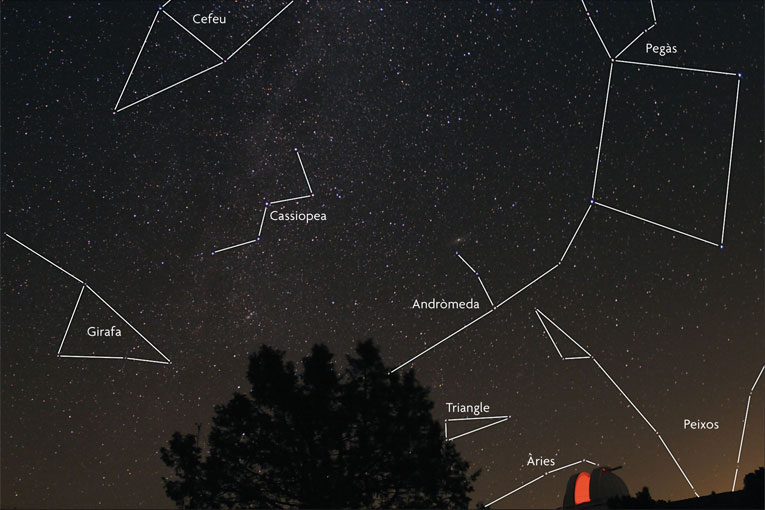 © Photo: Javier Díez (www.jdiez.com). Montage of the constellations: Fernando Ballesteros. © Photo: Javier Díez (www.jdiez.com). Montage of the constellations: Fernando Ballesteros.The night sky from the Observatory of the University of Valencia in Aras de los Olmos. In the photograph we can identify the Andromeda Galaxy, the furthest celestial object that is visible to the naked eye. The lines of the constellations have been drawn to facilitate their location in the sky. |
||
|
Although the night sky is certainly fascinating, we have to admit that the firmament observed from Earth seems rather placid. When the Sun sets, the brightest objects of the sky, after the Moon, are the planets Venus and Jupiter, the points of light that shine more than any other star, although in reality the three of them are reflecting the light they receive from the Sun. The brightest star, Sirius, is not a big one. It is similar to the Sun, slightly bigger and somewhat more luminous, but it is the brightest star in the sky due to its proximity to us: it is only 8.6 light-years from Earth. It is a stable star that, like the Sun, is going through a calm stage of its life that astronomers call the main sequence. If supergiant stars, like Rigel or Betelgeuse –which are at several hundred light-years from us, in the Orion constellation– were at the distance of Sirius, or at the distance of the nearest star, Proxima Centauri –at 4.2 light-years from Earth– they would compete in brightness with the Moon. Our sky would be very different. It is not unreasonable to think that for life to originate in a planet, like it has onEarth, its stellar surroundings would have to be relatively quiet. A night sky in a hypothetical planet in which there were stars as bright as the Moon could trigger catastrophic episodes. For instance, if one of those stars became a supernova, being so close to the planet, it would end any incipient development of life, or even well developed civilisations, who would helplessly watch their end. On Earth, this end will eventually happen. Of course, that will take about 5,000 million years, which is the time the Sun has left of its peaceful life and its main sequence before turning into a red giant, growing in size in such a way that its gaseous external layers will devour Earth (where there will be no life left at that point). But before this happens, and if we are capable of preserving our planet in the next billions of years –this little pale blue dot, as Carl Sagan would say– Earth’s inhabitants will be able to enjoy an ever-changing and really spectacular sky. This will be thanks to to the interactions with our neighbouring galaxies, mainly with Orion’s galaxy. |
||
 © NASA; ESA; Z. Levay and R. Van Der Marel, STScI; T. Hallas, and A. Mellinger © NASA; ESA; Z. Levay and R. Van Der Marel, STScI; T. Hallas, and A. MellingerSequence that shows what the night sky will look like – from Earth – with the future collision between our galaxy and the Andromeda Galaxy billions of years from now. |
||
|
Although we know that galaxies get further away from each other as a result of the cosmic expansion, those that are in a group or a gravitationally linked cluster move under the influence of mutual gravitational attraction and of all the mass of the group or cluster, including the dominant component of dark matter. This happens to the Local Group too, which consists of about forty galaxies, such as our galaxy, the Milky Way, and the Andromeda Galaxy, separated at about 2.5 million light-years. Both are falling over each other at a relative speed of 110 km/s today, which will increase with time, the same way the speed of an object in free fall increases. The separation of 2.5 million of light-years will decrease, both galaxies will get near each other, and before the collision, which will take place in about 4,000 million years, the night sky will visibly change. In the first image accompanying the article we can see the sky seen from Aras de los Olmos. It is a display of several seconds in which over the observatory the Andromeda Galaxy can be perfectly observed. We have drawn on the picture the lines of the close constellations, so as to make it easier to find the neighbouring galaxy. It can be seen in plain view, but above all, with the help of a pair of binoculars, it is not difficult to identify it (a good challenge for this summer if we have the chance to observe the sky from dark places, away from the light pollution). The eight images shown on the right page are a sequence of artistic illustrations that reveal how the collision will be observed from Earth. The first image corresponds to how the galaxy is currently seen (and it is similar to the one on the last page). The second shows the Andromeda Galaxy getting closer to the Earth as will be seen in about 2,000 million years. In the third, Andromeda practically fills the line of vision. This will happen in 3,750 million years. The next images show how the crash will activate the formation of new stars, turning the night sky into the greatest fireworks spectacle that we could imagine, which in addition will last hundreds of billions of years. The tidal forces will produce deformations in the discs of both spiral galaxies (as can be seen in the sixth image, which corresponds to 4,000 million years), but all in all, it is very likely that our Sun and its Solar System will not be destroyed, they will simply relocate to the suburbs of a new galaxy, this time elliptical, in which in 5,100 million years the nuclei of both galaxies – the Milky Way and Andromeda – will be visible and will finally (in 7,000 million years) merge into one, as the images of the last row of the artistic recreation show. These last sequences will probably not be seen from Earth, since by then our Sun will have started its own catastrophic journey and then – paraphrasing the president – «we will be on the verge of the Apocalypse» and the increase of the risk premium will surely not concern us anymore. Vicent J. Martínez. Astronomical Observatory of the University of Valencia. |
«In about 5,000 million years, the sun will turn into a red giant, growing in size in such a way that its gaseous external layers will devour the Earth» | |
© Mètode 2012 - 74. Online only. The Enchanted Cove - Summer 2012





